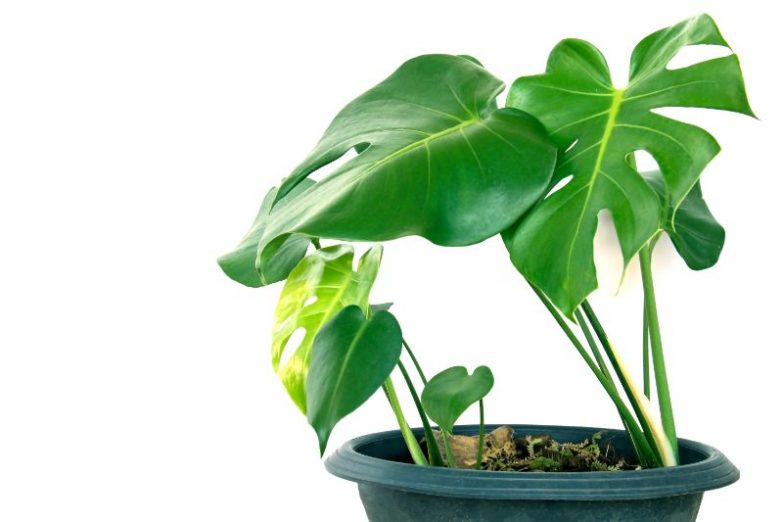Monstera deliciosa, otherwise known as Swiss Cheese Plants, are well-loved for their large glossy green leaves with beautiful and unusual perforations. But sometimes, these beautiful leaves start to turn yellow, which can be a cause for concern. This article will discuss the reasons why Monstera deliciosa plants get yellow leaves, how to identify the problem, and what you can do to fix your plant.
Why Does My Monstera deliciosa Have Yellow Leaves?
The most common causes of yellow leaves on Swiss Cheese Plants are:
- Over or under watering
- Low humidity
- Lighting Problems
- Temperature Stress
- Transplant stress / Stress after repotting
- Pests
- Diseases
- Fertilizer
- Old Foliage
- New Environment
The leaves on your Monstera plant should be glossy and dark green. Yellow leaves are often a sign that something is wrong and needs to be corrected. If you are struggling with yellow leaves on your Monstera deliciosa, keep reading to find out how to fix the problem.
Why Does My Monstera Deliciosa Have Yellow Leaves?
Watering Problems
Watering problems are the most common cause of yellow leaves in Swiss Cheese plants. If your plant has yellow leaves, the first step is to check the soil.
If the soil is dry and the plant looks dehydrated, with wilting of new growth, you may be underwatering your Swiss Cheese plant.
If the soil has been consistently soggy or drains poorly, or if you regularly forget to empty the drip tray after watering, then overwatering is the likely cause.
Overwatering typically causes generally yellow leaves, starting with the lower leaves first. Underwatering will cause yellow or brown leaf edges and new growth, before spreading to cause wilting and death of foliage generally.
Be aware that wilting can be caused by either overwatering or underwatering, so make sure to assess the entire plant, soil, and roots before deciding on corrective action.
To water your Swiss Cheese plant correctly, water it thoroughly until water comes out the drainage holes in the bottom. Allow the excess water to drain away and be sure to empty out any water that has collected in the saucer under the plant, if you have one. Wait to water the plant until the top inch or so of soil feels dry.
Most house plants will go dormant in the wintertime, meaning their metabolic processes will slow down and they will require less watering. In the summer, the heat may dry the soil out faster, requiring more frequent watering. Keep watching the moisture level of the soil to know when to water your Swiss Cheese plant again.
Read this helpful article about how to water houseplants the right way.
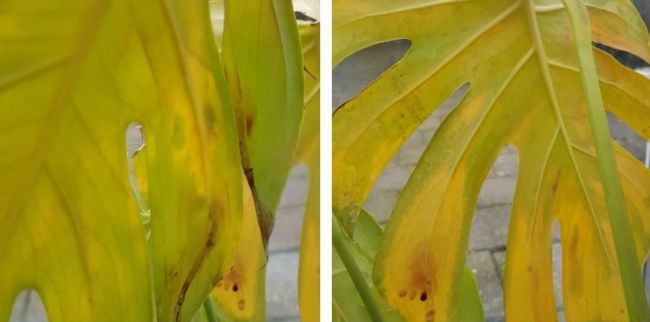
Low Humidity
As a tropical plant, Monstera plants prefer to have higher humidity. Although these plants can tolerate average home humidity for a while, long term exposure to lower humidity may cause the leaves to yellow or the ends to turn brown.
If this is the case, you may need to raise the humidity around your Swiss Cheese Plant by grouping it more closely with other plants or by placing it on top of a pebble tray filled with water. Read more about how to increase humidity for your houseplants here.
Lighting Problems
Poor lighting conditions in your home may be another cause for yellowing leaves in your Swiss Cheese plant. Swiss Cheese plants prefer bright, indirect light to help them thrive.
If the plant is in direct sunlight, the strong rays and heat may scorch the plant, causing the leaves to turn yellow and even brown. If this is the case, move the plant out of the direct rays of the sun to a location that receives bright but indirect light.
Too little light might also cause pale yellowish leaves. If the plant does not receive enough light, it won’t make enough chlorophyll to keep the leaves a healthy and glossy, dark shade of green.
If you have your Monstera in a dark room, you may also notice a loss of leaves, slowed growth, and the plant spreading or stretching out to find more light. If this is the case, you can either add a grow light to give the plant some extra lighting or move it to a brighter area of your home.
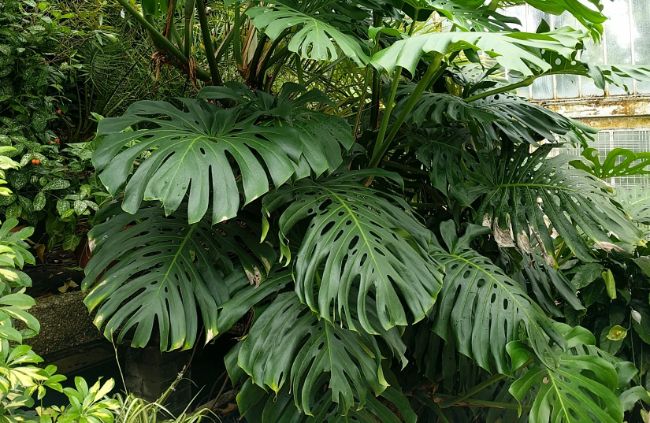
Temperature Stress
Most houseplants, such as Swiss Cheese plants, originated as tropical plants. Tropical plants generally grow best when temperatures are between 65-80 °F (18-27°C). When the temperature drops below 65°F, the plant’s growth will slow down. When the temperature drops below 50°F (10°C), the plant’s growth will likely stop altogether.
Additionally, tropical plants such as Swiss Cheese Plants do not do well with weather extremes or sudden changes. For example, if your plant is too close to a drafty door or window, an air conditioner or heat vent, or even a fireplace, the plant may begin turning yellow and dropping its leaves.
If you think this is the case, simply move your plant to a warmer, more temperature stable location of your home.
Transplant Stress
If your Monstera deliciosa develops yellow leaves after you’ve repotted it, it might be suffering from transplant stress. This could be caused by transplanting at the wrong time of year, transplanting into a different type of potting soil, leaving the roots exposed for too long, or moving the plant to a different location.
Once the damage is done, you can pamper your plant a bit to bring it back to life by:
- Making sure the plant has enough drainage. You may need to add drainage holes to the pot.
- Put the plant back into the same location you removed it from so that it has the same lighting and temperature as it did before you transplanted it.
- Prune off any dead or dying leaves.
- Avoid fertilizing for several months, as this can cause additional stress for your plant.
- Provide moderate lighting and water, as extremes of either, will worsen the situation
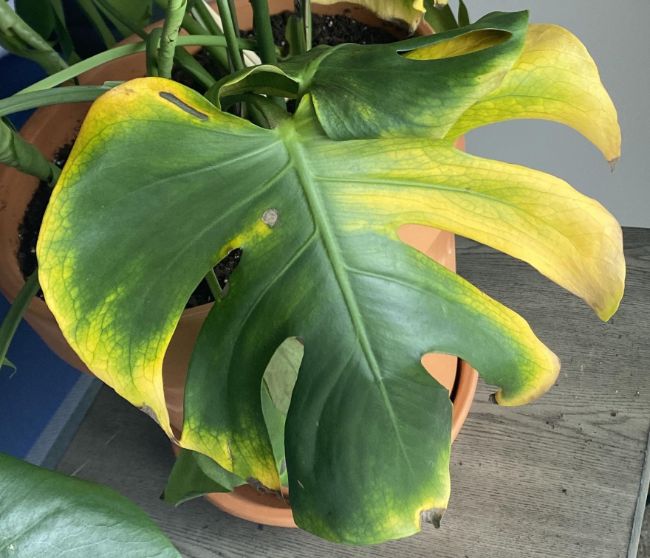
Pests
Damage from indoor plant pests can cause your Monstera’s leaves to develop yellow spots or generalized yellowing. Pests such as aphids and spider mites are common causes of yellowing leaves. These pests will attach to the plant and suck out the plant juices.
Aphids look like tiny white grains of rice on the stems and leaves of your plant. Spider mites are almost too small to be seen, but you will know they are there by the wispy webs strung between leaves. Grab a magnifying glass to take a closer look if you suspect spider mites have taken up residence.
Treatment depends on the individual pest, so read my guide to identifying, treating and preventing common houseplant pests to learn more.
Diseases
There are a number of plant diseases that can cause your Monstera deliciosa to have yellow leaves.
- Anthracnose: This is a disease caused by fungi. First the leaves will turn yellow, then eventually brown before they die. A wound in the plant increases the chances of the plant contracting this disease. Remove any infected leaves and spray with a fungicide labeled for this use.
- Fungal Leaf Spots: Leaf spots appear as brown spots with yellow margins. The fungi can be transferred through the soil. Remove infected leaves and do not get the leaves wet when watering as this can cause the fungi to spread. Use a commercial fungicide on the plant and make sure there is good circulation around it.
- Powdery Mildew: Powdery mildew is generally less serious, but a severe case can cause your monstera plant to fade, turn yellow, and even die. Before this happens, you may see a white, powdery growth forming on the leaves. Provide good air circulation to prevent this issue. Remove infected leaves. Sulfur or chlorothalonil sprays can be used to treat the rest of the plant.
Read my guide to identifying, treating and preventing common houseplant diseases for more information.
Fertilizer Problems
Although plants generally need some sort of fertilizer to continue to grow, too much or too little can cause your Swiss Cheese Plant leaves to turn yellow or become splotchy.
If you purchased your plant from a garden center, it may have arrived in soil with a slow-release fertilizer in it. Over time, though, the plant will deplete the soil and you will need to add some supplemental fertilizer.
I normally recommend fertilizing Monstera plants using a balanced, water-soluble fertilizer, applied at half the recommended strength on a monthly basis during the growing season. A little goes a long way, so it’s better to use a little fertilizer on a regular basis, rather than a lot infrequently.
The other side of the coin is overfertilizing. This is generally a more common problem, and more detrimental to the health of your plant.
Excessive fertilizer can cause a range of symptoms in your Monstera, including yellowing, sickly-looking leaves. Depending on whether the problem has been chronic excessive fertilizing, or an acute issue, the plant can show signs of both nutrient excess and nutrient deficiency.
The end result will normally be root damage, preventing your monstera from being able to absorb nutrients and water, significantly damaging the plant.
Look for evidence of salt deposits in the soil, or review how often and how much you have been fertilizing when considering this cause.
First, try flushing the soil with copious amounts of water to try to flush out the excess salts. Do not fertilize your Monstera again for at least 3 months and provide care conditions well within the comfort zone of the plant.
You could also try to repot your Monstera, although this can sometimes cause additional stress for your plant, so this should be considered a last resort.
Read this guide to fertilizing your houseplants for more information about getting this crucial aspect of care right.
Old Foliage
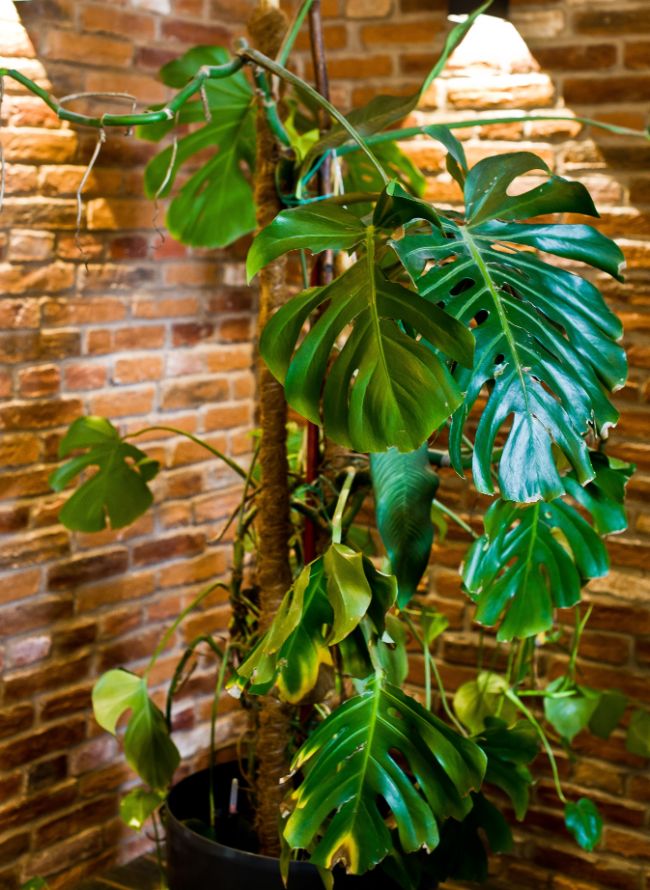
Sometimes, Monstera Deliciosa have yellow leaves as a natural part of plant growth. As the plant grows and gets older, the leaves around the bottom of the plant may turn yellow, droop, and then fall off.
It is quite normal for plants to shed old leaves that are no longer needed, especially as the plant grows bigger and taller. This type of yellowing is not a cause for concern, but just a natural process of the plant. You can gently remove the dying leaves.
Acclimating To A New Environment
Sometimes, a plant will turn yellow and drop leaves after you first bring it home or you move it to a new location. This is not a cause for concern. As the plant adjusts to new lighting conditions, it may drop off some of its leaves because it cannot support them all.
As it adjusts to its new location, it will begin to grow new foliage. Avoid repotting your plant during this time until it has fully adjusted to its new location so you don’t cause any further stress.

